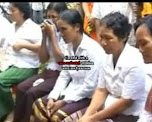A testimony of the antiquity of the Khmer language are the multitude of epigraphic inscriptions on stone. The first written proof that has allowed the history of the Khmer Kingdom to be reconstructed are those inscriptions. These writings on columns, stelae and walls throw light on the royal lineages, religious edicts, territorial conquests and internal organization of the kingdom.
Khmer Wovels
Following the stone inscriptions, some of the oldest Khmer documents are translations and commentaries of the Pali Buddhist texts of the Tripitaka. They were written by the monks on palmyra palm leaves and kept in various monasteries throughout the country.
The Ram Ker (Rama’s fame) is the Cambodian version of the Ramayana, the famous Indian epic. The Ram Ker comes in rhymed verses and is staged in sections that are adapted to dance movements interpreted by local artists. The Ram Ker is the oldest form of Cambodian theatre.
Cambodia had a rich and varied traditional oral literature. There are many legends, tales and songs of very ancient origin that were not put into writing until the arrival of the Europeans. One of the most representative of these tales was the story of Vorvong and Sorvong (Vorvong and Saurivong), a long story about two Khmer princes that was first put into writing by Auguste Pavie. This French civil servant claimed that he had obtained the story from old Uncle Nip in Somrontong District. This story was put into writing in Battambang. In 2006 the Vorvong and Sorvong story was enacted in dance form by the Royal Ballet of Cambodia.
Khmer alphabets:
Tum Teav which has been compared to a local version of Shakespeare’s Romeo and Juliet, is a Khmer famous literature, originally based on a poem written by a Khmer Monk named Sam. The story is took place during Lovek era, about tragic love story that has been told throughout Cambodia since at least the middle of the 19th century.The story has been portrayed in many forms including oral, historical, literary, theatre, and film adaptions. The story also have a role in Cambodia’s education in the 12th grade as a topic for Khmer language examination for several times. Although its first translation in French had been made by Étienne Aymonier already in 1880, Tum Teav was popularized abroad when writer George Chigas translated the 1915 literary version by the venerable Buddhist monk Preah Botumthera Som or Padumatthera Som, known also as Som, one of the best writers in the Khmer language.
The notable people especially in royalty caste which in attraction and talented in khmer literature known as King Ang Duong (1841–1860) and King Thommaracha II (1629–1634). King Thomaracha had reserved for Khmer young generation with a well loved poem and an educated poem while King Ang Duong famous for his novel called Kakey, an inspiration from Jataka tales about an unfaithful woman and a female law which now become a notable law, used to teach the young khmer girl in some notable famil today. Quoted from Wikipedia.








0 comments:
Post a Comment